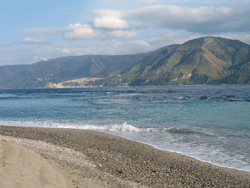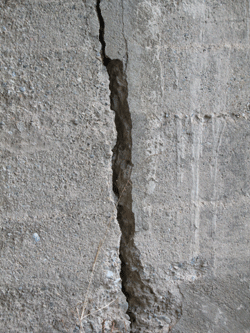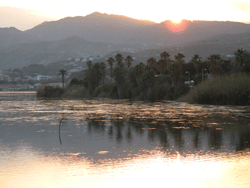Bridging the Straits of Messina
Air Date: Week of April 7, 2006

Ferries travel between Messina, Sicily and Villa San Giovanni, Calabria every 15 minutes. (Photo: Ken Shulman)
The narrow sea passage between the island of Sicily and mainland Italy is a busy crossing for commuters and local merchants, as well as an important channel for bird, fish, and sea mammal migrations. Plans for a bridge across the Straits of Messina has environmentalists and many residents up in arms, while supporters see the bridge as vital to the region’s economic future. Ken Shulman reports.
Transcript
CURWOOD: It’s Living on Earth. I’m Steve Curwood. As voters in Italy elect their new parliament, a controversial public works project hangs in the balance: a proposed bridge across the Straits of Messina that would connect the island of Sicily with southern Italy. Incumbent Prime Minister Silvio Berlusconi supports the project, which would open Sicily as a major port. His opponent Romano Prodi opposes it. So do many ecologists and geologists who are concerned about the earthquake history of the region, as well as the fragile Mediterranean ecosystem. Ken Shulman has our report.
[GANGPLANK, FERRY SOUNDS]

Ferries travel between Messina, Sicily and Villa San Giovanni, Calabria every 15 minutes. (Photo: Ken Shulman)
[TRUCK OF CHICKENS]
SHULMAN: But the proposed bridge across the Straits of Messina is not intended for these commuters. Nor is it intended for local merchants, like this Sicilian chicken farmer waiting to truck his fowl to market.
Lorenzo Falciai is spokesperson for Stretto di Messina SPA, the company that handles the business end of the bridge project.
FALCIAI [SPEAKS IN ITALIAN] [VOICEOVER]: Marine traffic in the region is growing by double digits every year. Trade with Asia is growing exponentially, and this trade is exploding across the Mediterranean. As a nation, we have to put Sicily and Calabria in a condition where they can intercept this traffic.
SHULMAN: The bridge across the Straits of Messina is intended to provide a stable rail and automobile link between Sicily and mainland Italy and Europe, completing the so-called Berlin-Palermo land corridor. It’s a strategic gamble and, perhaps, a necessary one. Sicily and Calabria suffer from endemic unemployment and underdevelopment. There is no high-speed rail line, and few highways worthy of the name. Falciai believes the bridge will be an economic catalyst.
FALCIAI: [VOICEOVER] It’s not like Sicily and Calabria are deserts and the bridge is the magic wand that will transform these deserts into gardens. The bridge is one piece in the mosaic. And a big one. That’s why it must be one of the first works undertaken. And I hope that by 2012, or by 2015, when the bridge will be completed, the other infrastructure elements will be completed as well.
[SEA SOUNDS]

The dark, cold waters of the Ionian Sea meet the light, cool waters of the Tyrenian, forming whirlpools and riptides. (Photo: Ken Shulman)
[CAR SOUNDS]
SHULMAN: Emilio De Domenico is a professor of oceanography at the University of Messina. He fears that the fine particles, dust, and runoff from the predicted 350 million square feet of excavation necessary to build the bridge will suffocate the marine invertebrates and phytoplankton, both prime links of the Strait’s food chain. De Domenico lives in Ganzirri, the zone where much of the bridge work will take place. If construction begins by the end of the year, as the company hopes, De Domenico will have to move. Yet it’s not because of his house, the professor claims, that he’s against the bridge.
DOMENICO: [VOICEOVER] I’m against it because it’s already a dinosaur. A showpiece that will be completely useless, that will not improve the economy, that we aren’t even sure can be built, but that we are sure will destroy one of the most beautiful areas in all of the Mediterranean.
[TRUCKS UNLOADING]
SHULMAN: Except for a few busy weeks in summer, it’s only a ten minute wait and a 20 minute ferry ride from Messina to Villa San Giovanni. This small Calabrian town is the northern end of the proposed bridge, and site of one of the structure’s two mammoth 1,253-foot towers – towers taller than the Eiffel Tower. The two massive suspension cables that will support the two-mile-long deck will also be anchored here, and on the hills above Ganzirri on the Sicilian side.
[CLIMBING SOUNDS]
SHULMAN: The Straits of Messina run between two tectonic plates, the plates between the African and European landmasses. Earthquakes are frequent here, including major ones like the shock that leveled the city of Messina in 1908. Ferdinando Jovine is a geologist living in Villa San Giovanni. He believes the two plates are moving apart.

This crack formed in a 10 year old highway column on the Calabrian side, a few feet from the site of the proposed bridge tower. (Photo: Ken Shulman)
SHULMAN: The researchers at Stretto di Messina don’t share Jovine’s conclusions. Enzo Vullo is chief engineer at the Rome-based company. He says that because of its mass and flexibility, a suspension bridge has the best chance of any structure of surviving a major earthquake. He also disputes Jovine’s other data.
VULLO: [VOICEOVER] There is a movement of the soil, but it doesn’t involve the bedrock beneath, which is where we will anchor the towers and cables. And the two coasts aren’t pulling apart; they’re actually rotating in unison. But even if it were true, we’re talking about a millimeter or two per year, or 16 inches over the next 200 years. The bridge will expand three times that distance in summer with the heat.
[CHURCH BELLS]

One of two brackish water lakes just north of Messina, Sicily. They host hundreds of fish and bird species, and offer food and rest to migratory birds. (Photo: Ken Shulman)
One of the environmentalists’ greatest fears is that the proposed bridge will be yet another abandoned public works project, leaving behind only an irreversible ecological disaster. Stretto di Messina officials say this is unlikely. As a publicly owned company, they say, they have a responsibility to their shareholders and investors to finish the job, and on time.
[CAR DRIVING BY]
SHULMAN: Lago di Faro is one of two brackish water lakes in Ganzirri. The lakes are connected by short canals to the sea, and serve as nursery and refuge for countless species of birds and fish. Until recently, poachers used to drive to the lakeside, step out of their cars, and shoot egrets, herons, and migratory falcons who’d stop at the lake for a final meal before flying across the Strait. If you drive there today, the birds will flee as soon as you turn off your motor.
[SHELLFISH SORTING]
SHULMAN: Pippo Donato owns a shellfish farm and processing plant on the lake. Like many locals, he was initially in favor of the bridge. But, like many locals, he’s changed his position – even though his business stands to benefit.
DONATO: [VOICEOVER] My opinion started to change after my son was born. I started to think about those who would live here after I’m gone. And I think that it is our duty to leave behind this landscape, as it is, intact.
SHULMAN: Not all locals along the Strait are against the project. Emma D’Agostino runs a bar in downtown Messina, near the city hall. She tells her clients that the bridge will be a shot in the arm for Messina, which is badly in need of one.
D’AGOSTINO: [VOICEOVER] Right now nobody stops in Messina. They all go on to other places. The bridge will create jobs, and it will bring us tourists. Buses. Trains. These people will use our hotels, our restaurants. We’ll be able to eat again.
SHULMAN: The people who support the bridge say they speak for Sicily’s future. Those against the bridge claim to speak for the future, as well. But it’s a different future, a future where Sicily builds roads, railroads, and hotels, and uses its unparalleled archaeology, beaches, and climate to develop an economy based on sustainable agriculture and eco-tourism. At stake is a spectacular piece of land, steeped in history and myth, but mired in corruption, and mismanagement.
For Living on Earth, I’m Ken Shulman, in Messina, Italy.
Links
Living on Earth wants to hear from you!
Living on Earth
62 Calef Highway, Suite 212
Lee, NH 03861
Telephone: 617-287-4121
E-mail: comments@loe.org
Newsletter [Click here]
Donate to Living on Earth!
Living on Earth is an independent media program and relies entirely on contributions from listeners and institutions supporting public service. Please donate now to preserve an independent environmental voice.
NewsletterLiving on Earth offers a weekly delivery of the show's rundown to your mailbox. Sign up for our newsletter today!
 Sailors For The Sea: Be the change you want to sea.
Sailors For The Sea: Be the change you want to sea.
 The Grantham Foundation for the Protection of the Environment: Committed to protecting and improving the health of the global environment.
The Grantham Foundation for the Protection of the Environment: Committed to protecting and improving the health of the global environment.
 Contribute to Living on Earth and receive, as our gift to you, an archival print of one of Mark Seth Lender's extraordinary wildlife photographs. Follow the link to see Mark's current collection of photographs.
Contribute to Living on Earth and receive, as our gift to you, an archival print of one of Mark Seth Lender's extraordinary wildlife photographs. Follow the link to see Mark's current collection of photographs.
 Buy a signed copy of Mark Seth Lender's book Smeagull the Seagull & support Living on Earth
Buy a signed copy of Mark Seth Lender's book Smeagull the Seagull & support Living on Earth

